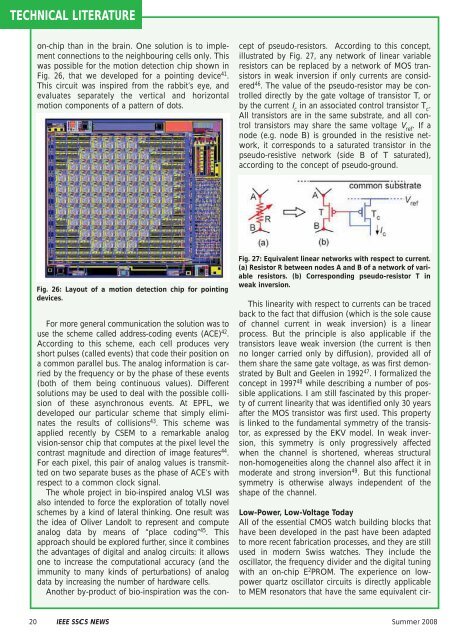Eric Vittoz - IEEE
Eric Vittoz - IEEE
Eric Vittoz - IEEE
Create successful ePaper yourself
Turn your PDF publications into a flip-book with our unique Google optimized e-Paper software.
TECHNICAL LITERATURE<br />
on-chip than in the brain. One solution is to implement<br />
connections to the neighbouring cells only. This<br />
was possible for the motion detection chip shown in<br />
Fig. 26, that we developed for a pointing device 41 .<br />
This circuit was inspired from the rabbit’s eye, and<br />
evaluates separately the vertical and horizontal<br />
motion components of a pattern of dots.<br />
Fig. 26: Layout of a motion detection chip for pointing<br />
devices.<br />
For more general communication the solution was to<br />
use the scheme called address-coding events (ACE) 42 .<br />
According to this scheme, each cell produces very<br />
short pulses (called events) that code their position on<br />
a common parallel bus. The analog information is carried<br />
by the frequency or by the phase of these events<br />
(both of them being continuous values). Different<br />
solutions may be used to deal with the possible collision<br />
of these asynchronous events. At EPFL, we<br />
developed our particular scheme that simply eliminates<br />
the results of collisions 43 . This scheme was<br />
applied recently by CSEM to a remarkable analog<br />
vision-sensor chip that computes at the pixel level the<br />
contrast magnitude and direction of image features 44 .<br />
For each pixel, this pair of analog values is transmitted<br />
on two separate buses as the phase of ACE’s with<br />
respect to a common clock signal.<br />
The whole project in bio-inspired analog VLSI was<br />
also intended to force the exploration of totally novel<br />
schemes by a kind of lateral thinking. One result was<br />
the idea of Oliver Landolt to represent and compute<br />
analog data by means of “place coding” 45 . This<br />
approach should be explored further, since it combines<br />
the advantages of digital and analog circuits: it allows<br />
one to increase the computational accuracy (and the<br />
immunity to many kinds of perturbations) of analog<br />
data by increasing the number of hardware cells.<br />
Another by-product of bio-inspiration was the con-<br />
cept of pseudo-resistors. According to this concept,<br />
illustrated by Fig. 27, any network of linear variable<br />
resistors can be replaced by a network of MOS transistors<br />
in weak inversion if only currents are considered<br />
46 . The value of the pseudo-resistor may be controlled<br />
directly by the gate voltage of transistor T, or<br />
by the current I c in an associated control transistor T c .<br />
All transistors are in the same substrate, and all control<br />
transistors may share the same voltage V ref . If a<br />
node (e.g. node B) is grounded in the resistive network,<br />
it corresponds to a saturated transistor in the<br />
pseudo-resistive network (side B of T saturated),<br />
according to the concept of pseudo-ground.<br />
Fig. 27: Equivalent linear networks with respect to current.<br />
(a) Resistor R between nodes A and B of a network of variable<br />
resistors. (b) Corresponding pseudo-resistor T in<br />
weak inversion.<br />
This linearity with respect to currents can be traced<br />
back to the fact that diffusion (which is the sole cause<br />
of channel current in weak inversion) is a linear<br />
process. But the principle is also applicable if the<br />
transistors leave weak inversion (the current is then<br />
no longer carried only by diffusion), provided all of<br />
them share the same gate voltage, as was first demonstrated<br />
by Bult and Geelen in 1992 47 . I formalized the<br />
concept in 1997 48 while describing a number of possible<br />
applications. I am still fascinated by this property<br />
of current linearity that was identified only 30 years<br />
after the MOS transistor was first used. This property<br />
is linked to the fundamental symmetry of the transistor,<br />
as expressed by the EKV model. In weak inversion,<br />
this symmetry is only progressively affected<br />
when the channel is shortened, whereas structural<br />
non-homogeneities along the channel also affect it in<br />
moderate and strong inversion 49 . But this functional<br />
symmetry is otherwise always independent of the<br />
shape of the channel.<br />
Low-Power, Low-Voltage Today<br />
All of the essential CMOS watch building blocks that<br />
have been developed in the past have been adapted<br />
to more recent fabrication processes, and they are still<br />
used in modern Swiss watches. They include the<br />
oscillator, the frequency divider and the digital tuning<br />
with an on-chip E 2 PROM. The experience on lowpower<br />
quartz oscillator circuits is directly applicable<br />
to MEM resonators that have the same equivalent cir-<br />
20 <strong>IEEE</strong> SSCS NEWS Summer 2008




